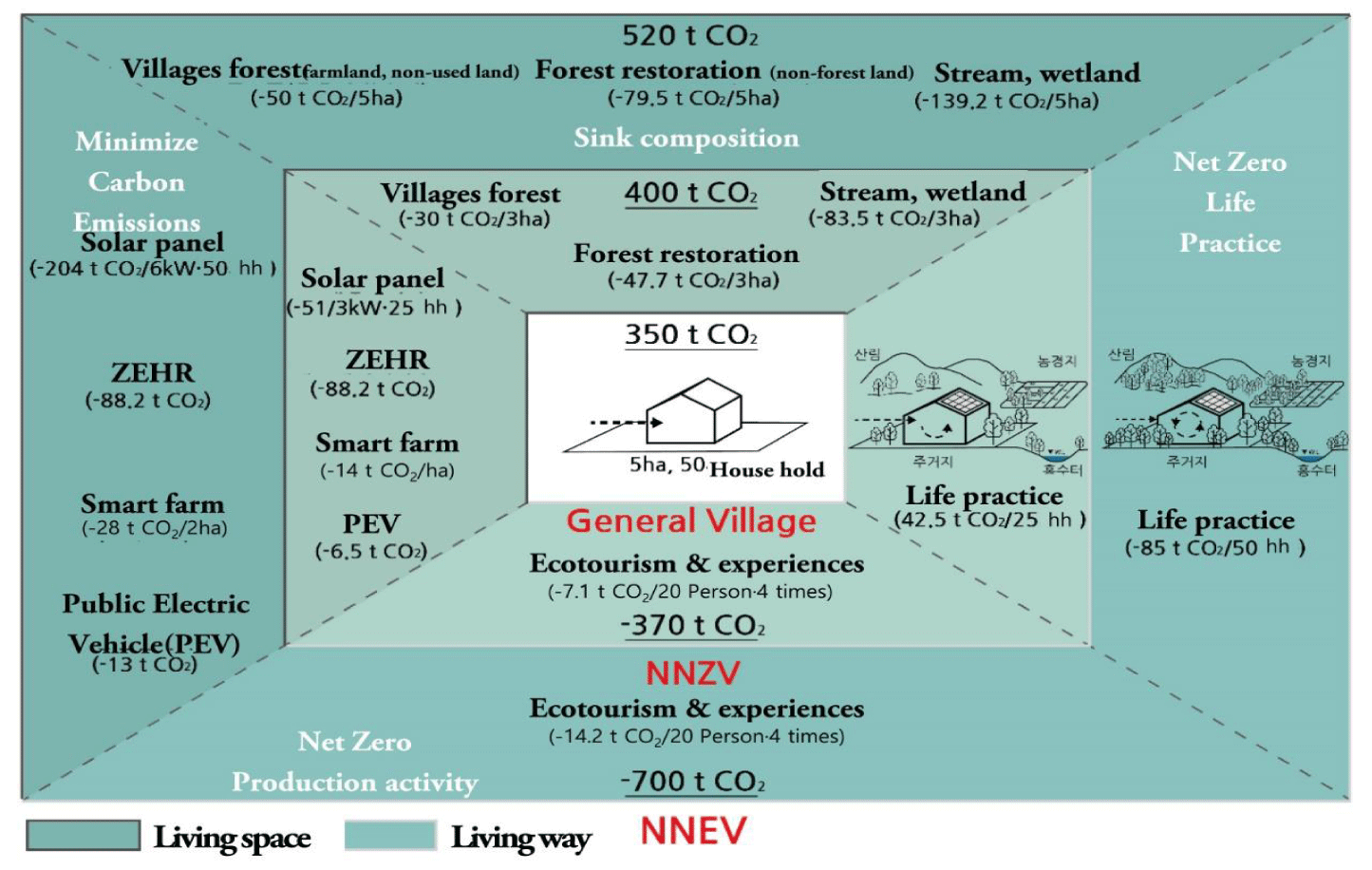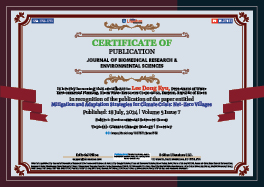Environmental Sciences Group. 2024 July 18;5(7):770-772. doi: 10.37871/jbres1953.
Mitigation and Adaptation Strategies for Climate Crisis: Net-Zero Villages
Byung Chul An1, Hwan Dong Seong2 and Dong Kyu Lee3*
2Department of Landscaping and Leisure, Dong-Il Technology Corporation, Seoul, Republic of Korea
3Department of Water Environmental Planning, Korea Water Resources Corporation, Daejeon, Republic of Korea
- Climate change
- Climate crisis
- Net-zero
- Mitigation and adaptation
- Greenhouse gas
- Paris agreement
- UNFCCC
Abstract
To respond to the climate crisis, we are responding globally by setting the goal of Net Zero. These response strategies are being divided into mitigation and adaptation, but most studies emphasize the mitigation aspect, and research on this is the main focus. However, to respond to the climate crisis, adaptation aspects must also be considered, which may most closely affect changes and transitions in human life. Net Zero Villages is an implementation strategy to respond to the climate crisis and can be used in all aspects of mitigation and adaptation. In this study, Net Zero Villages Model was presented to help assess specific planning factors for Net Zero at the village level.
Introduction
With the implementation of the Paris Agreement by the United Nations Framework Convention on Climate Change (UN-FCCC), the world is transitioning toward a new goal of 'Net Zero by 2050', and global efforts are being made to minimize the increase in global average temperature for human survival. The goal of the Paris Agreement is to keep the increase in global average temperature below 2°C compared to pre-industrial levels as suggested in the Kyoto Protocol, but it is set to be limited to 1.5°C or less, and each party agrees to actively work toward this goal. Response strategies for this are largely divided into reduction and adaptation. Mitigation refers to reducing the phenomenon of global warming caused by human activities, reducing the sources of greenhouse gases that cause global warming, or expanding greenhouse gas sinks. Adaptation refers to reducing damage by controlling various risk factors that are currently occurring or expected to occur in the future due to climate change using natural and artificial systems, and further transforming them to be beneficial to our lives. This study seeks to discuss the modeling of Net Zero Villages that can be used as a mitigation and adaptation strategy to respond to the climate crisis.
Net zero villages
The definition of Net Zero in this study was set as the sum of net greenhouse gas emissions being ‘0’, referring to Rogeli J, et al. [1]. The state in which the sum of net greenhouse gas emissions is ‘0’ means that the net emissions that offset the amount of greenhouse gas absorption from the amount of greenhouse gases emitted, released, or leaked into the atmosphere are ‘0’. In addition, a village was seen as a social group created by people leaving their homes to live together with people from other households, and a place where several houses gathered together and lived together as the minimum unit of a local group [2].
Considering this comprehensively, the concept of Net Zero Villages in this study was established as a village that induces greenhouse gases generated in a village, the smallest unit of a spatially distinguishable local group, to be '0' through artificial efforts such as improving living spaces in the physical aspect and changing lifestyles in the non-physical aspect.
Looking at previous studies related to Net Zero at home and abroad, research on detailed implementation plans on how to implement Net Zero is insufficient. Internationally, the global goal according to the United Nations Framework Convention on Climate Change (UNFCCC) has been set as Net Zero, but it is believed that no detailed implementation plan and detailed imple-mentation plan for each sector have been discussed to date. In addition, most research on Net Zero is focused on the energy sector, so there are limits to what the general public can perceive.
Net Zero-related policies are mainly implemented in a top-down manner, emphasizing the quantitative reduction aspect by setting a ‘baseline’ target of low carbon emissions. However, this government-led top-down approach has limitations in social consensus and active participation of residents. Accordingly, this study aimed to spread Net Zero to villages, the basic spatial unit where residents live, to spread it to the region and contribute to Net Zero of the entire country. In addition, rather than the existing top-down approach, we attempted to present a carbon-neutral village model so that the implementation plan can be implemented bottom-up through resident participation-based improvement of living space and lifestyle change.
Net zero villages models
A village model capable of Net Zero was schematized as shown in the figure using the planning factors of previous re-search, the unit cost per factor, and the scenario analysis results [3]. To enable Net Zero at the village level, living spaces and lifestyles were divided, and models enabling Near Net Zero Village (NNZV) and Negative Net Zero Village (NNEV) were presented.
Assuming that the residential area is 5ha and the number of households is 50, General Village set the standard emissions as 350 t CO2 eq as of 2020, referring to previous studies. NNZV is a case of introducing planning factors such as utilization of ecological resources, creation of sinks, minimization of carbon emissions, and Net Zero cooperative production activities in the General Village. In 2030, the emission reduction and absorption amount will reach -370 t CO2 eq, which can reduce the net emissions to less than 100 t CO2, and it is suggested that Near Net Zero will be possible through the creation of Net Zero forests and expansion of solar power facility capacity. NNEV presented the expected emissions of 520 t CO2 eq in 2050 and suggested that if Net Zero Villages planning factors are introduced, the emissions and absorption amounts to approximately -700 t CO2 eq, suggesting that Net Negative Emissions beyond Net Zero are possible.
In order to verify the feasibility of the model, scenario analysis was conducted on four villages representing four regions in Korea. As a result, it was found that Net Zero is possible when Net Zero village planning factors are applied to all villages, and when planning factors are applied at a more challenging level, it was analyzed that NNEV is possible beyond Net Zero.
Conclusion
The climate crisis is a challenge of the times that must be responded to globally, and to this end, the goal of Net Zero have been set. Meanwhile, scientific data continues to emerge that human activities are directly related to the rise in Earth's temperature due to increased greenhouse gas emissions. Accordingly, to realize Net Zero, changes in human activities are necessary, and this can be expected to play the greatest role when carried out at the village level, which is the smallest unit of the local group. Net Zero Villages best meet the needs of the times can be used as a social movement through the voluntary participation of residents, and can be a useful tool in bringing about changes in living spaces and lifestyles.
Acknowledgment
None.
Conflicts of Interest
The authors declare no conflict of interest.
References
- Rogelj J, Schaeffer M, Meinshausen M, Knutti R, Alcamo J, Riahi K, Hare W. Zero emission targets as long-term global goals for climate protection. Environmental Research Letters. 2015;10(10):105007. doi: 10.1088/1748-9326/10/10/105007.
- Park SH, Park CH. A study on the research methodology for village studies. Journal of the Korean Regional Development Association. 1993;5(2):71-90.
- Lee DK, An BC. Analysis of contribution to net zero of non-urban settlement: For green infrastructure in rural areas. The Korean Institute of Landscape Architecture. 2022;50(3):19-34. doi: 10.9715/KILA.2022.50.3.019.
Content Alerts
SignUp to our
Content alerts.
 This work is licensed under a Creative Commons Attribution 4.0 International License.
This work is licensed under a Creative Commons Attribution 4.0 International License.









